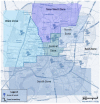A cross-sectional, randomized cluster sample survey of household vulnerability to extreme heat among slum dwellers in ahmedabad, india
- PMID: 23778061
- PMCID: PMC3717750
- DOI: 10.3390/ijerph10062515
A cross-sectional, randomized cluster sample survey of household vulnerability to extreme heat among slum dwellers in ahmedabad, india
Abstract
Extreme heat is a significant public health concern in India; extreme heat hazards are projected to increase in frequency and severity with climate change. Few of the factors driving population heat vulnerability are documented, though poverty is a presumed risk factor. To facilitate public health preparedness, an assessment of factors affecting vulnerability among slum dwellers was conducted in summer 2011 in Ahmedabad, Gujarat, India. Indicators of heat exposure, susceptibility to heat illness, and adaptive capacity, all of which feed into heat vulnerability, was assessed through a cross-sectional household survey using randomized multistage cluster sampling. Associations between heat-related morbidity and vulnerability factors were identified using multivariate logistic regression with generalized estimating equations to account for clustering effects. Age, preexisting medical conditions, work location, and access to health information and resources were associated with self-reported heat illness. Several of these variables were unique to this study. As sociodemographics, occupational heat exposure, and access to resources were shown to increase vulnerability, future interventions (e.g., health education) might target specific populations among Ahmedabad urban slum dwellers to reduce vulnerability to extreme heat. Surveillance and evaluations of future interventions may also be worthwhile.
Figures



Similar articles
-
Vulnerability and Adaptation to Extreme Heat in Odisha, India: A Community Based Comparative Study.Int J Environ Res Public Health. 2019 Dec 12;16(24):5065. doi: 10.3390/ijerph16245065. Int J Environ Res Public Health. 2019. PMID: 31842287 Free PMC article.
-
Characteristics of Households' Vulnerability to Extreme Heat: An Analytical Cross-Sectional Study from India.Int J Environ Res Public Health. 2022 Nov 20;19(22):15334. doi: 10.3390/ijerph192215334. Int J Environ Res Public Health. 2022. PMID: 36430053 Free PMC article.
-
Mapping community determinants of heat vulnerability.Environ Health Perspect. 2009 Nov;117(11):1730-6. doi: 10.1289/ehp.0900683. Epub 2009 Jun 10. Environ Health Perspect. 2009. PMID: 20049125 Free PMC article.
-
Association of ambient extreme heat with pediatric morbidity: a scoping review.Int J Biometeorol. 2022 Aug;66(8):1683-1698. doi: 10.1007/s00484-022-02310-5. Epub 2022 Jun 25. Int J Biometeorol. 2022. PMID: 35751701 Free PMC article.
-
Minimization of heatwave morbidity and mortality.Am J Prev Med. 2013 Mar;44(3):274-82. doi: 10.1016/j.amepre.2012.11.015. Am J Prev Med. 2013. PMID: 23415125 Review.
Cited by
-
Racial and socioeconomic disparities in heat-related health effects and their mechanisms: a review.Curr Epidemiol Rep. 2014 Sep 1;1(3):165-173. doi: 10.1007/s40471-014-0014-4. Curr Epidemiol Rep. 2014. PMID: 25512891 Free PMC article.
-
Socioenvironmental factors associated with heat and cold-related mortality in Vadu HDSS, western India: a population-based case-crossover study.Int J Biometeorol. 2017 Oct;61(10):1797-1804. doi: 10.1007/s00484-017-1363-8. Epub 2017 May 19. Int J Biometeorol. 2017. PMID: 28527152 Free PMC article.
-
Vulnerability and Adaptation to Extreme Heat in Odisha, India: A Community Based Comparative Study.Int J Environ Res Public Health. 2019 Dec 12;16(24):5065. doi: 10.3390/ijerph16245065. Int J Environ Res Public Health. 2019. PMID: 31842287 Free PMC article.
-
Using Uncertain Climate and Development Information in Health Adaptation Planning.Curr Environ Health Rep. 2016 Mar;3(1):99-105. doi: 10.1007/s40572-016-0077-0. Curr Environ Health Rep. 2016. PMID: 26814795 Review.
-
Heat Emergencies: Perceptions and Practices of Community Members and Emergency Department Healthcare Providers in Karachi, Pakistan: A Qualitative Study.Int J Environ Res Public Health. 2021 Apr 29;18(9):4736. doi: 10.3390/ijerph18094736. Int J Environ Res Public Health. 2021. PMID: 33946755 Free PMC article.
References
-
- Akhtar R. Climate change and health and heat wave mortality in India. Glob. Environ. Res. 2007;11:51–57.
-
- Attri S., Tyagi A. Climate Profile of India. Environment Monitoring and Research Center, India Meteorology Department; New Delhi, India: 2010.
-
- Christensen J., Hewitson B., Busuioc A., Chen A., Gao X., Held I., Jones R., Kolli R., Kown W.-T., Laprise R., et al. In: Regional Climate Projections in Climate Change 2007: The Physical Science Basis. Contribution of Working Group I to the Fourth Assessment Report of the Intergovernmental Panel on Climate Change. Solomon S., Qin D., Manning M., Chen Z., Marquis M., Averyt K., Tignor M., Miller H., editors. Cambridge University Press; Cambridge, UK: 2007.
-
- Confalonieri U., Menne B., Akhtar R., Ebi K.L., Hauengue M., Kovats R.S., Revich B., Woodward A. Human health. In: Parry M.L., Canziani O.F., Palutikof J.P., van der Linden P.J., Hanson C.E., editors. Climate Change 2007: Impacts, Adaptation and Vulnerability. Contribution of Working Group II to the Fourth Assessment Report of the Intergovernmental Panel on Climate Change. Cambridge University Press; Cambridge, UK: 2007. pp. 391–431.
Publication types
MeSH terms
LinkOut - more resources
Full Text Sources
Other Literature Sources
Medical
Research Materials

